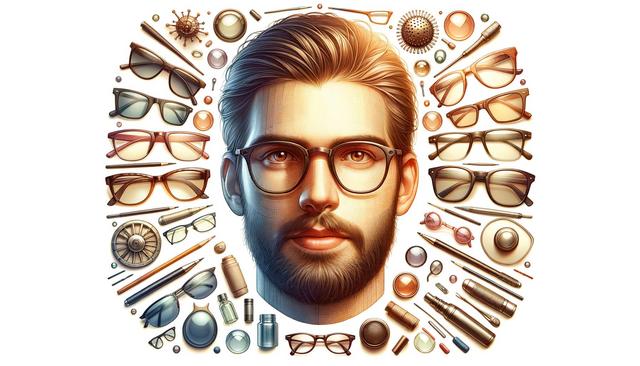Understanding the Purpose of Glasses
Glasses are primarily designed to correct vision problems such as nearsightedness, farsightedness, astigmatism, and presbyopia. By adjusting the way light enters the eye, glasses help individuals see more clearly and comfortably. For many, they are a daily necessity that significantly improves quality of life. Common types of corrective lenses include single vision lenses for general use, bifocals for dual-distance vision, and progressive lenses that transition smoothly between different focal points. These options allow wearers to maintain visual clarity in a variety of situations, from reading a book to driving a car.
In addition to vision correction, glasses can also serve as a protective barrier. For people working in environments with high dust levels or potential eye hazards, safety glasses with impact-resistant lenses are crucial. Similarly, computer glasses help reduce eye strain caused by long hours in front of screens. These specialized lenses often include blue light filters, which can alleviate symptoms like dry eyes and headaches.
The Evolution of Eyeglasses Over Time
The history of eyeglasses dates back to the 13th century, with early designs consisting of convex lenses mounted in rudimentary frames. Over time, the materials and craftsmanship have dramatically improved. From hand-ground glass to high-tech polycarbonate lenses, the evolution of glasses reflects advancements in optical science and manufacturing. Today, modern glasses are lighter, more durable, and offer a wide range of customization options.
Frame styles have also changed significantly. Initially functional and basic, frames now come in a variety of shapes, colors, and materials, including metal, acetate, and even wood. This shift has transformed glasses into fashion accessories as well as medical devices. As society has embraced glasses not just for necessity but also for self-expression, eyewear designers have responded with collections that reflect current trends and individual preferences.
Choosing the Right Glasses for Your Needs
Selecting the right pair of glasses involves more than just picking a frame that looks good. It’s important to consider factors such as face shape, lifestyle, and the specific visual needs of the wearer. Optometrists often guide patients through this process, ensuring the chosen eyewear meets both functional and aesthetic requirements. Here are some considerations to keep in mind when choosing glasses:
- Face Shape: Different frame styles complement different face shapes (e.g., round, oval, square).
- Lens Type: Options include single vision, multifocal, and digital screen lenses.
- Material: Lightweight materials like titanium offer comfort, while acetate provides bold style choices.
- Coatings: Anti-reflective, UV protection, and scratch-resistant coatings enhance lens performance.
By evaluating these elements, wearers can find glasses that support their vision while matching their personal style and daily activities.
Glasses as a Fashion Statement
In recent years, glasses have gained popularity as a fashion accessory, even among individuals who don’t require vision correction. Non-prescription lenses allow people to enjoy the aesthetic appeal of glasses without affecting their eyesight. This trend has led to an explosion of frame designs, with eyewear brands collaborating with fashion designers and celebrities to release limited-edition collections.
Wearing glasses can enhance facial features, project a certain image, or serve as a signature look. Whether someone prefers a vintage-inspired frame, a minimalist rimless design, or bold geometric shapes, there are options to suit every taste. Some popular fashion-forward frame trends include:
- Transparent acetate frames
- Gold or silver wire frames
- Oversized square or round lenses
- Tortoiseshell and patterned finishes
Glasses are no longer seen solely as medical devices but as versatile tools for self-expression.
Taking Care of Your Glasses
Proper maintenance is essential to extend the life of glasses and ensure optimal performance. Neglecting care can lead to scratched lenses, loose hinges, and reduced visual clarity. Basic cleaning with a microfiber cloth and lens-friendly solution helps remove smudges and debris without damaging coatings. Avoid using paper towels or clothing, which can scratch the lens surface.
Storage is another important aspect. Glasses should be kept in a protective case when not in use and placed lens-side up to prevent damage. Regular adjustments by an optician can also keep the frame aligned and comfortable. Here are some quick tips for everyday care:
- Rinse lenses under lukewarm water before cleaning
- Avoid leaving glasses in hot environments, such as car dashboards
- Tighten screws with a small eyeglass screwdriver if they become loose
- Visit an optical store for professional cleaning and tune-ups
By incorporating these habits, users can prolong the life of their eyewear and maintain visual comfort throughout the day.
Conclusion: Seeing Clearly with Style and Purpose
Glasses play a vital role in modern life, supporting both vision and personal style. Whether used for corrective purposes, protection, or fashion, they offer a blend of utility and expression. Choosing the right pair involves thoughtful consideration of both practical needs and aesthetic preferences. With proper care and regular updates, glasses can remain a reliable and stylish companion in daily life. For anyone navigating the world of eyewear, understanding the diverse options and benefits available can lead to a clearer, more confident outlook.




Leave a Reply